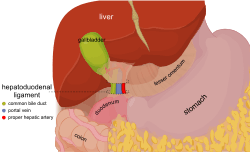Hepatoduodenal ligament
The hepatoduodenal ligament is the portion of the lesser omentum extending between the porta hepatis of the liver and the superior part of the duodenum.
| Hepatoduodenal ligament | |
|---|---|
 Ligament with its contents partially exposed | |
| Details | |
| Identifiers | |
| Latin | ligamentum hepatoduodenale |
| TA | A10.1.02.105 |
| FMA | 16521 |
| Anatomical terminology | |
Running inside it are the following structures collectively known as the portal triad:[1]
Manual compression of the hepatoduodenal ligament during surgery is known as the Pringle Maneuver. The hepatoduodenal ligament should not be confused with the cystoduodenal ligament. The cystoduodenal ligament is also found in the lesser omentum and is distinct from the hepatoduodenal and hepatogastric ligaments. It represents a variation in the anatomy of the omental bursa and its foramen [2]
References
This article incorporates text in the public domain from page 1151 of the 20th edition of Gray's Anatomy (1918)
- Anatomy figure: 38:02-06 at Human Anatomy Online, SUNY Downstate Medical Center - "Contents of the hepatoduodenal ligament."
- Ashaolu, J; Ukwenya, V; Adenowo, T (2011). "Cystoduodenal ligament as an abnormal fold and the accompanying anatomical and clinical implications". Surg Radiol Anat. 33 (2): 171–174. doi:10.1007/s00276-010-0736-z. PMID 20976455.
External links
- Anatomy figure: 37:04-03 at Human Anatomy Online, SUNY Downstate Medical Center - "The stomach and lesser omentum."
- Anatomy image:7830 at the SUNY Downstate Medical Center
- abdominalcavity at The Anatomy Lesson by Wesley Norman (Georgetown University)
- Peritoneal Cavity Development - Page 6 of 14 anatomy module at med.umich.edu